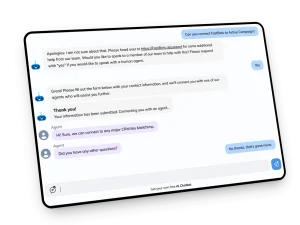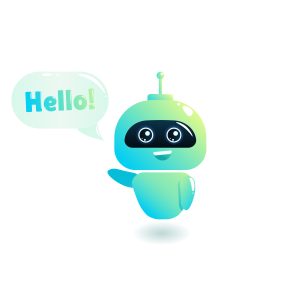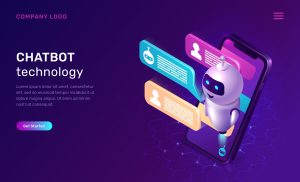The landscape of customer engagement is undergoing a revolutionary transformation. As we stand at the threshold of 2025 and beyond, artificial intelligence is not merely augmenting traditional customer support and sales processes—it’s fundamentally redefining them. AI chatbots have evolved from simple rule-based systems to sophisticated conversational agents capable of understanding context, emotions, and complex business scenarios. This technological evolution is reshaping how businesses interact with customers, drive sales, and deliver value in an increasingly competitive marketplace.

The convergence of advanced natural language processing, machine learning, and generative AI has created unprecedented opportunities for businesses to automate, personalize, and optimize their customer interactions. It is projected that AI bots will power 95% of all customer service interactions by 2025, signaling a paradigm shift that forward-thinking organizations cannot afford to ignore.
The Current State of AI Chatbots: Setting the Foundation
Technological Maturity and Capabilities
Modern AI chatbots have transcended their primitive origins to become sophisticated business tools powered by advanced technologies. A key trend for 2024 and beyond is the rise of AI-powered chatbots, led by models like GPT-4 and other large language models (LLMs). These systems can understand context, maintain conversation continuity, and provide intelligent responses that closely mirror human interaction patterns.
The integration of machine learning algorithms has enabled chatbots to learn from every interaction, continuously improving their performance and accuracy. Natural language processing capabilities have reached a level where chatbots can understand nuanced language, detect sentiment, and respond appropriately to complex queries.
Market Adoption and Business Impact
The adoption of AI chatbots is accelerating across industries, driven by compelling business outcomes and evolving customer expectations. According to Juniper Research, companies are expected to save $8 billion annually by 2025 by deploying AI-powered chatbots and customer support solutions. This significant cost savings is accompanied by improvements in customer satisfaction, operational efficiency, and revenue generation.
The number of chatbot users is going to exceed 1.5 billion people by 2025, indicating widespread consumer acceptance and integration of AI-powered conversational interfaces into daily business interactions.
Emerging Trends Shaping the Future
Voice-Enabled Conversational Interfaces
With the rise of voice AI, emotional intelligence, and multimodal capabilities, AI chatbots trends in 2025 will be more than just thoughts. They will be critical business assets, shaping the future of customer engagement. Voice-enabled chatbots are becoming increasingly sophisticated, leveraging the same technologies that power virtual assistants like Siri, Alexa, and Google Assistant.
2025 will be significant due to several factors: Rise of voice-enabled chatbots. Technology that’s present in Cortana, Siri, and Alexa will be integrated into business chatbots, enabling more natural and intuitive customer interactions. This evolution will particularly benefit mobile-first businesses and organizations serving customers who prefer voice interactions over text-based communication.
Emotional Intelligence and Human-like Interactions
One of the most significant trends in AI chatbot technology is the development of increasingly human-like interactions. Advancements in Natural Language Processing (NLP) and machine learning are enabling chatbots to understand context, nuances, and emotions in user conversations with unprecedented accuracy.
The integration of emotional AI allows chatbots to detect customer sentiment, adapt their communication style accordingly, and provide empathetic responses. This capability is particularly valuable in customer support scenarios where understanding emotional context is crucial for effective problem resolution.
Multimodal Capabilities and Rich Media Integration
Future AI chatbots will seamlessly integrate text, voice, images, and video to create rich, interactive experiences. This multimodal approach enables chatbots to provide visual assistance, share multimedia content, and guide customers through complex processes using multiple communication channels simultaneously.
The ability to process and respond to images, documents, and video content will expand the range of customer service scenarios that chatbots can handle independently, reducing the need for human intervention in previously complex interactions.

Revolutionizing Customer Support Operations
Proactive Customer Engagement
The future of AI chatbots extends beyond reactive customer support to proactive engagement strategies. Advanced predictive analytics enable chatbots to identify potential issues before they escalate, reach out to customers with relevant information, and provide personalized recommendations based on usage patterns and preferences.
BotPulse.live exemplifies this proactive approach by offering chatbots that can analyze customer behavior patterns and initiate conversations at optimal moments, increasing engagement rates and customer satisfaction scores.
Omnichannel Integration and Consistency
Future AI chatbots will provide seamless experiences across all customer touchpoints, maintaining conversation context and customer history regardless of the channel used. Whether customers interact via website chat, mobile app, social media, or voice assistants, the chatbot will provide consistent, personalized service.
This omnichannel approach ensures that customers can start a conversation on one platform and continue it on another without losing context or having to repeat information, significantly improving the overall customer experience.
Advanced Problem Resolution
AI chatbots are evolving to handle increasingly complex customer issues through advanced reasoning capabilities and integration with backend systems. They can access customer data, transaction history, and product information to provide comprehensive solutions without human intervention.
The integration of generative AI enables chatbots to create custom solutions, generate detailed explanations, and even produce documentation or troubleshooting guides tailored to specific customer situations.
Transforming Sales Automation
Intelligent Lead Qualification and Nurturing
Our research suggests that a fifth of current sales-team functions could be automated, with AI chatbots playing a crucial role in this transformation. Modern sales chatbots can qualify leads more effectively than traditional methods by engaging prospects in natural conversations, asking relevant questions, and scoring leads based on their responses and behavior.
An AI sales funnel uses artificial intelligence technologies to optimize and automate the customer journey from the initial point to the final purchase. AI enhances the traditional sales funnel by leveraging data, algorithms, and machine learning to analyze customer behaviors and patterns.
Personalized Sales Experiences
Generative AI will enhance virtual sales by creating customized sales pitches and proposals for each prospect. As more sales move online, AI helps simulate face-to-face interactions, making virtual meetings more personalized and engaging.
AI chatbots can analyze customer data, preferences, and purchase history to deliver highly personalized product recommendations, pricing information, and sales presentations. This level of personalization increases conversion rates and customer satisfaction while reducing the time and effort required from sales teams.
Conversational Commerce and Instant Transactions
The future of sales automation includes seamless integration of conversational interfaces with e-commerce platforms, enabling customers to browse, select, and purchase products directly through chatbot interactions. This conversational commerce approach reduces friction in the buying process and provides a more natural shopping experience.
Instant Checkout Options: E-commerce-like experiences for B2B buyers will enable faster purchasing, even for complex solutions. In 2025, sales funnels won’t remain static. They will evolve continuously, powered by generative AI that tests and optimizes strategies in real time.
Real-time Sales Optimization
In today’s dynamic business environment, decision-making in sales and marketing is shifting from reflective to reflexive, leveraging real-time data and AI to enable immediate, context-aware responses. AI chatbots contribute to this transformation by providing real-time insights, adjusting sales strategies based on customer responses, and optimizing conversion paths dynamically.

Technological Advancements Driving Innovation
Large Language Models and Generative AI
The integration of advanced large language models (LLMs) like GPT-4 and beyond is revolutionizing chatbot capabilities. These models enable chatbots to understand complex queries, generate human-like responses, and engage in sophisticated conversations that were previously impossible for automated systems.
Generative AI capabilities allow chatbots to create custom content, generate reports, draft emails, and produce personalized marketing materials, expanding their utility beyond simple question-and-answer interactions.
Agentic AI and Autonomous Decision Making
The top trends in new AI frontiers and the focus on enterprises include AI reasoning, custom silicon, cloud migrations, systems to measure AI efficacy and building an agentic AI future. Agentic AI represents the next evolution of chatbots, where they can take autonomous actions on behalf of users and businesses.
These advanced systems can make decisions, execute transactions, schedule appointments, and perform complex multi-step processes without human intervention. The development of agentic AI will enable chatbots to function as virtual employees capable of handling entire customer journeys independently.
Edge Computing and Real-time Processing
The deployment of edge computing technologies will enable chatbots to process information and respond to queries with minimal latency, even in bandwidth-constrained environments. This advancement is particularly important for mobile applications and IoT devices where real-time response is critical.
Edge-deployed chatbots can also operate offline or with limited connectivity, ensuring consistent service availability regardless of network conditions.
Industry-Specific Applications and Use Cases
Healthcare and Telemedicine
AI chatbots in healthcare are evolving to provide more sophisticated diagnostic support, patient monitoring, and treatment guidance. According to Business Insider, more than 70% of healthcare admin tasks will be automated by artificial intelligence, with chatbots playing a central role in this automation.
Future healthcare chatbots will integrate with medical devices, electronic health records, and diagnostic tools to provide comprehensive patient support and clinical decision assistance.
Financial Services and Fintech
The financial sector is embracing AI chatbots for fraud detection, investment advice, loan processing, and customer service. Advanced chatbots can analyze financial data, assess credit risk, and provide personalized financial planning recommendations.
The integration of blockchain technology and secure processing capabilities will enable chatbots to handle sensitive financial transactions with enhanced security and compliance.
Education and E-learning
Chatbot trends for 2025 include evolving capabilities of education tools. The chatbot for educational institutions developed by CHI Software is an example of a chatbot that focuses on providing a more interactive experience for each student.
Educational chatbots are becoming sophisticated tutoring systems capable of adapting to individual learning styles, providing personalized curriculum recommendations, and offering real-time academic support.
Retail and E-commerce
Retail chatbots are evolving into comprehensive shopping assistants that can handle product discovery, comparison shopping, inventory management, and post-purchase support. The integration of augmented reality and visual recognition technologies will enable chatbots to provide virtual try-on experiences and visual product recommendations.

Implementation Strategies for Forward-Thinking Organizations
Choosing the Right AI Platform
Selecting the appropriate AI chatbot platform is crucial for successful implementation. Organizations should evaluate platforms based on their natural language processing capabilities, integration options, scalability, security features, and alignment with business objectives.
BotPulse.live offers a comprehensive platform that addresses these requirements while providing the flexibility needed for complex enterprise deployments. The platform’s advanced AI capabilities and seamless integration options make it an ideal choice for organizations looking to implement cutting-edge chatbot solutions.
Developing a Comprehensive AI Strategy
Successful AI chatbot implementation requires a holistic approach that considers organizational goals, customer needs, technical requirements, and change management processes. Organizations should develop clear use cases, establish success metrics, and create implementation roadmaps that align with their digital transformation objectives.
Training and Continuous Improvement
AI chatbots require ongoing training and optimization to maintain effectiveness and adapt to changing customer needs. Organizations should establish processes for regular model updates, performance monitoring, and continuous learning based on customer interactions and feedback.
The implementation of feedback loops and A/B testing methodologies ensures that chatbots evolve and improve over time, delivering increasingly better results for both customers and businesses.
Challenges and Considerations
Data Privacy and Security
As AI chatbots handle increasingly sensitive customer information, organizations must implement robust security measures and comply with data protection regulations. This includes encryption, secure data storage, access controls, and transparent privacy policies.
The development of privacy-preserving AI techniques, such as federated learning and differential privacy, will enable organizations to improve chatbot performance while protecting customer data.
Ethical AI and Bias Mitigation
Ensuring that AI chatbots operate ethically and without bias is crucial for maintaining customer trust and regulatory compliance. Organizations must implement bias testing, fairness metrics, and ethical AI guidelines throughout the development and deployment process.
Integration Complexity
Integrating AI chatbots with existing systems, databases, and workflows can be complex and requires careful planning. Organizations should consider integration requirements early in the planning process and work with experienced providers to ensure seamless deployment.
Change Management and Adoption
Successful AI chatbot implementation often requires significant organizational change, including employee training, process modifications, and cultural adaptation. Organizations should develop comprehensive change management strategies to ensure smooth adoption and maximize the benefits of their AI investments.
Measuring Success and ROI
Key Performance Indicators
Organizations should establish clear metrics for measuring chatbot performance, including customer satisfaction scores, resolution rates, response times, cost savings, and revenue impact. These metrics provide insights into chatbot effectiveness and areas for improvement.
Advanced Analytics and Insights
Modern AI chatbot platforms provide sophisticated analytics capabilities that enable organizations to gain deep insights into customer behavior, preferences, and interaction patterns. These insights can inform business strategy, product development, and customer experience optimization.
Continuous Optimization
Successful AI chatbot implementations require ongoing optimization based on performance data, customer feedback, and changing business requirements. Organizations should establish processes for regular review and improvement of their chatbot systems.
The Road Ahead: Predictions for the Next Decade
Ubiquitous AI Presence
By 2030, AI chatbots will be ubiquitous across all digital touchpoints, providing seamless, intelligent assistance in every customer interaction. The distinction between human and AI-powered support will become increasingly blurred as chatbots achieve near-human levels of understanding and empathy.
Hyper-Personalization
Future AI chatbots will deliver hyper-personalized experiences by leveraging vast amounts of customer data, behavioral patterns, and contextual information. Every interaction will be tailored to individual preferences, needs, and circumstances, creating unique experiences for each customer.
Autonomous Business Operations
AI chatbots will evolve into autonomous business agents capable of handling complex business processes, making strategic decisions, and managing entire customer relationships without human intervention. This evolution will enable organizations to achieve unprecedented levels of efficiency and scalability.
Predictive and Prescriptive Capabilities
Advanced AI chatbots will not only respond to customer needs but also predict future requirements and proactively recommend solutions. This predictive capability will enable organizations to stay ahead of customer needs and provide value before problems arise.
Conclusion: Embracing the AI-Powered Future
The future of AI chatbots in customer support and sales automation represents a fundamental shift in how businesses interact with customers and drive growth. Organizations that embrace this transformation will gain significant competitive advantages through improved customer experiences, operational efficiency, and revenue growth.
In 2025, AI automation is all set to revolutionize B2B marketing and sales, offering solutions to challenges like increasing competition and evolving customer behaviors. The key to success lies in understanding these trends, implementing robust AI strategies, and continuously evolving with technological advancements.
BotPulse.live stands at the forefront of this revolution, providing organizations with the tools and expertise needed to implement cutting-edge AI chatbot solutions that deliver measurable results. By partnering with experienced providers and embracing innovative technologies, businesses can position themselves for success in the AI-powered future.
The journey toward AI-powered customer support and sales automation is not just about adopting new technology—it’s about reimagining how businesses create value, serve customers, and compete in an increasingly digital marketplace. Organizations that act now will be best positioned to capitalize on the transformative potential of AI chatbots and lead their industries into the future.
As we look ahead to the next decade, the question is not whether AI chatbots will transform customer support and sales—it’s how quickly organizations can adapt to harness their full potential. The future belongs to those who embrace this transformation and leverage AI to create exceptional customer experiences that drive sustainable business growth.
Frequently Asked Questions (FAQs)
1. How will AI chatbots impact employment in customer support and sales teams?
AI chatbots will not replace human workers but rather augment their capabilities and shift their roles toward higher-value activities. While routine tasks will be automated, human agents will focus on complex problem-solving, relationship building, and strategic decision-making. Studies suggest that a fifth of current sales functions could be automated, but this creates opportunities for sales professionals to concentrate on relationship management, consultative selling, and strategic account development. Organizations should invest in retraining programs to help employees transition to these evolved roles.
2. What are the key technological requirements for implementing advanced AI chatbots in 2025?
Implementing advanced AI chatbots requires robust cloud infrastructure, integration capabilities with existing systems, and access to large language models or generative AI platforms. Organizations need secure data storage, real-time processing capabilities, and APIs for connecting with CRM, ERP, and other business systems. Additionally, they require advanced analytics platforms for monitoring performance and continuous improvement. Platforms like BotPulse.live provide comprehensive solutions that address these technical requirements while offering scalability and security.
3. How can businesses ensure their AI chatbots remain ethical and unbiased?
Ensuring ethical AI chatbots requires implementing bias testing throughout the development process, using diverse training data, and establishing clear ethical guidelines. Organizations should conduct regular audits to identify and address potential biases, implement fairness metrics, and maintain transparency in AI decision-making processes. Additionally, businesses should establish human oversight mechanisms, provide clear escalation paths, and regularly review chatbot interactions to ensure they align with organizational values and ethical standards.
4. What is the expected ROI timeline for AI chatbot implementations in customer support and sales?
Most organizations can expect to see positive ROI from AI chatbot implementations within 6-12 months, with full ROI typically achieved within 18-24 months. Companies are expected to save $8 billion annually by 2025 through AI-powered customer support solutions, with individual organizations reporting cost savings of 20-30% and efficiency improvements of 40-60%. The exact timeline depends on implementation complexity, use case scope, and organizational readiness. Key factors include proper training, system integration, and continuous optimization.
5. How will conversational commerce evolve with AI chatbots in the coming years?
Conversational commerce will become increasingly sophisticated, with AI chatbots enabling seamless end-to-end purchasing experiences through natural language interactions. By 2025, chatbots will integrate with e-commerce platforms to provide personalized product recommendations, handle complex transactions, and offer instant checkout options. This evolution will include voice-enabled purchasing, visual product search, and AI-powered negotiation capabilities. The integration of augmented reality and virtual try-on experiences will further enhance conversational commerce, making it a primary channel for customer acquisition and retention.
References
- CHI Software. (2025, February 21). The Future Trends of AI Chatbots in 2025 and Beyond. Retrieved from https://chisw.com/blog/future-trends-in-ai-chatbots/
- Peerbits. AI Chatbot Trends 2025: Voice AI, Emotional AI, and Beyond. Retrieved from https://www.peerbits.com/blog/ai-chatbot-trends.html
- Salesmate. Navigating AI Automation Trends: Key Insights for 2025 and Beyond. Retrieved from https://www.salesmate.io/blog/ai-automation-trends/
- Botpress. Key Chatbot Statistics for 2025: Perceptions, Market Growth, Trends. Retrieved from https://botpress.com/blog/key-chatbot-statistics
- Chatbase. Top 10 AI Chatbot Trends for 2025: What to Watch. Retrieved from https://www.chatbase.co/blog/chatbot-trends
- Tidio. (2024, October 18). The Future of Chatbots: 80+ Chatbot Statistics for 2025. Retrieved from https://www.tidio.com/blog/chatbot-statistics/
- Springs Apps. (2025, February 10). The Chatbot Market In 2025: Forecasts and Latest Statistics. Retrieved from https://springsapps.com/knowledge/the-chatbot-market-in-2024-forecasts-and-latest-statistics
- Master of Code Global. (2025). BEST Chatbot Statistics for 2025. Retrieved from https://masterofcode.com/blog/chatbot-statistics
- ProProfs Chat. (2025, March 7). 60+ Chatbot Statistics, Facts & Trends for 2025 & Beyond. Retrieved from https://www.proprofschat.com/blog/chatbot-statistics/
- Morgan Stanley. 5 AI Trends Shaping Innovation and ROI in 2025. Retrieved from https://www.morganstanley.com/insights/articles/ai-trends-reasoning-frontier-models-2025-tmt
- NICE. Generative AI for Customer Interaction in 2025: Transforming CX with Automation and Personalization. Retrieved from https://www.nice.com/info/generative-ai-for-customer-interaction-in-2025-transforming-cx-with-automation-and-personalization
- McKinsey & Company. (2023, May 11). AI-powered marketing and sales reach new heights with generative AI. Retrieved from https://www.mckinsey.com/capabilities/growth-marketing-and-sales/our-insights/ai-powered-marketing-and-sales-reach-new-heights-with-generative-ai
- Copy.ai. The AI Sales Funnel: How It’s Changing the Game for Sales Leaders. Retrieved from https://www.copy.ai/blog/ai-sales-funnel
- AI Multiple. Generative AI for Sales Use Cases in 2025. Retrieved from https://research.aimultiple.com/generative-ai-for-sales/
- Sales Mind AI. AI Sales Funnel: 5 AI Tools to Optimize Your Funnel. Retrieved from https://sales-mind.ai/blog/ai-sales-funnel
- Neil Patel. (2025, January 15). 9 AI Tools for Successful Marketing Funnels. Retrieved from https://neilpatel.com/blog/ai-marketing-funnels/
- Franki T. (2025, January 7). The Top Ways Sales Funnels Are Going to Change in 2025. Retrieved from https://www.francescatabor.com/articles/2025/1/7/the-top-ways-sales-funnels-are-going-to-change-in-2025
- Funnel.io. (2025, January 13). The generative AI revolution: What marketers should expect in 2024. Retrieved from https://funnel.io/blog/2024-marketing-predictions
- PRNewswire. (2025). New Gen Launches to Power AI-Native Commerce, Equipping Brands with Conversational Digital Storefronts. Retrieved from https://www.prnewswire.com/news-releases/new-gen-launches-to-power-ai-native-commerce-equipping-brands-with-conversational-digital-storefronts-302459784.html
- Harvard Business Review. (2025, June 6). Companies Are Using AI to Make Faster Decisions in Sales and Marketing. Retrieved from https://hbr.org/2025/06/companies-are-using-ai-to-make-faster-decisions-in-sales-and-marketing
Botpulse is proudly powered by WordPress